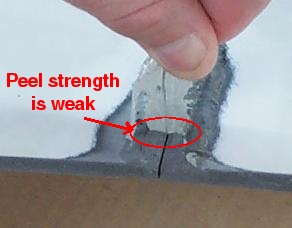We help people repair plastic
Urethane weld peels up when pulling at the edge of the weld
Problem:
After welding a urethane bumper, the weld will peel up when I pull at the edge of the weld.

Possible causes:
Before explaining the possible cause, it is important to know the distinction between thermoplastics and thermoset plastics.
· Thermoplastic bumpers are made by injecting heated plastic material into a mold and allowing the heated material to cool and solidify. With thermoplastics, you can "undo" the process by reheating the material. For example, if you wanted to make a bumper out of ice,you could inject "heated" ice (water) into the mold and freeze it. If you wanted to undo the process, you could heat up the ice and turn it into water.
· Thermoset bumpers are made by injecting different chemicals into the mold where they can react. After the chemical reaction has occured, there is no way to undo the reaction. Urethane bumpers are thermoset plastics.
Since the "weld" relies on adhesive strength, the "weld" will peel up when pulled at. The weld does not have a lot of peel strength. By looking at the picture above, the circled area shows where the weld is being peeled from the substrate. The thin line where the substrate and the weld meet is where all of the pulling forces are concentrated. The adhesion of the urethane weld is greater when there is increased surface area to which the urethane weld will stick. The small amount of surface area at the edge is insufficient surface area and, therefore, the urethane weld will peel.
One way to think about this is to think about when you are removing a band-aid. It's a lot easier to peel the band-aid than it is to try and remove it without peeling it.
When you weld urethane, you are not actually performing a true "weld". You are really doing a process similar to brazing or using hot-melt glue. When you heat the base material, you are not really melting the plastic. You are really destroying and burning the plastic. Once the plastic has been burned, it is difficult to get the rod to stick to it.
Go ahead and peel up what you can. You will need to start over. Just melt the urethane rod (Part No. R01-01-03-NT) into the V-groove. Do NOT try to melt base material. For more information on welding urethane bumpers, follow the instructions in "The Book". When you have completed the weld, do not try to peel the weld. If you need to test the strength of the weld, allow the weld to cool and pull at the welded-together pieces. This way, the entire surface area of the weld will be tested, rather than the small area described above.
Products Suggestions

